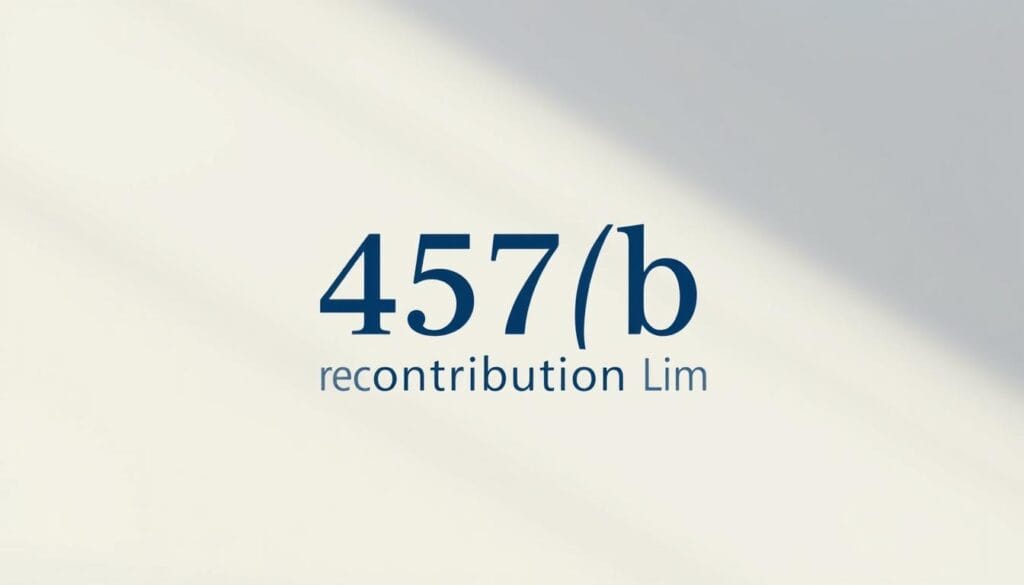Surprising fact: nearly one in four public-sector workers can access a 457(b) account, a lesser-known savings vehicle that can change how seniors manage income in later life.
What it is: This employer-sponsored option helps certain state local government and eligible nonprofit employees defer income into a tax-advantaged account. Two main types exist: governmental accounts held in trust and non-governmental accounts that remain employer-owned.
Key 2025 facts: Annual elective deferrals are capped, and some plans offer Roth choices plus special catch-up windows for older workers. These features affect how much you can save and the tax mix between pre-tax and tax-free withdrawals.
Withdrawals after leaving service often avoid the 10% early-withdrawal penalty that applies to many other accounts. Still, asset protection differs: trust-held accounts have stronger creditor shields than employer-owned assets.
Key Takeaways
- These accounts serve state local government and certain nonprofit employees to defer income.
- There are two types with different protections: trust-held vs employer-owned.
- 2025 contribution limits and catch-up options can boost savings for seniors.
- Penalty rules and RMD timing affect taxable income in retirement years.
- Check whether your employer offers Roth or special catch-up features.
- Coordinate this account with other accounts and review rollover rules.
- Compare options using resources like a guide to top 401(k) plans.
What seniors need to know right now about 457(b) retirement plans

Start by asking HR whether your employer offers a governmental 457 and which options are open to you this year.
Key 2025 limits: elective deferrals top out at $23,500. Governmental accounts may accept Roth contributions. Age-based catch-ups are available: $7,500 for 50+, and the SECURE 2.0 super catch-up for ages 60–63 is $11,250 in 2025.
Withdrawals after you leave service avoid the 10% early-distribution penalty that applies to many other accounts, though ordinary income tax still applies. Required minimum distributions start at age 73, but a still-working exception can delay RMDs from your current employer account.
- Verify whether your employer offers this option and which rules apply to your account.
- Check how much room remains under the limit and whether you can increase contributions without straining cash flow.
- Decide between pre-tax and Roth contributions based on current income tax and future goals.
| Feature | 2025 Amount | Notes |
|---|---|---|
| Elective deferral limit | $23,500 | Annual cap for most employees |
| Age 50+ catch-up | $7,500 | Available for eligible participants |
| SECURE 2.0 super catch-up (60–63) | $11,250 | Higher catch-up for select ages in 2025 |
For guidance on coordinating accounts and maximizing saving opportunities, consider resources like top IRA accounts for beginners.
How a 457(b) works: plan types, tax treatment, and who’s eligible

For government and certain nonprofit workers, a deferred compensation vehicle offers payroll-based savings with distinct tax and creditor rules.
Defining the account: A deferred compensation arrangement lets employees agree to defer part of their pay into an account. Contributions reduce current taxable income when made pre-tax, or grow tax-free if the employer’s option allows designated Roth contributions.
Who is eligible: These plans serve state and local government employers and many 501(c) tax-exempt organizations. Typical participants include city staff, school and university employees, hospital workers, and nonprofit employees. Participation usually happens through a salary reduction agreement.
Governmental accounts
Governmental 457 accounts generally hold assets in trust for participants. That structure offers stronger protection from employer creditors and lets funds roll into IRAs, 401(k)s, or 403(b)s after separation.
Non-governmental accounts
Non-governmental 457 accounts remain employer-owned. Investment choices may be limited, and assets can be exposed to creditor risk. In most cases, those funds cannot roll over to IRAs or other workplace accounts.
- Contributions are made via payroll deferrals and follow the employer’s election rules.
- Eligibility and the defined retirement age affect access to catch-up options and distribution timing.
- Review your plan documents to confirm options, fees, and creditor protections before deferring pay.
457b retirement plan details: 2025 contribution limits and catch-up contributions

Start by checking how much you can defer this year and whether your pay limits that amount.
2025 elective deferral limit: The basic contribution limit for 2025 is $23,500 or your includible compensation for the year, if that amount is lower. If you work for a governmental 457 plan,you may be eligible for extra catch-up choices.
Age 50+ catch-up
Governmental plans allow an additional $7,500 in 2025 for participants age 50 or over. Non-governmental plans do not offer this age-based option.
SECURE 2.0 super catch-up (ages 60–63)
Starting in 2025, participants aged 60–63 in governmental accounts can use a higher catch-up. The 2025 amount is $11,250 and replaces the standard age 50 catch-up for those years.
Three‑year normal retirement age catch-up
The 3-year catch-up lets eligible workers within three years of their chosen normal retirement age contribute more by using unused prior years’ room. You must pick either the 3-year option or an age-based catch-up for a given year — not both.
- Limits apply across all employer plans combined in a year.
- Any employer contributions that the plan allows count toward your individual limit.
- Examples for 2025: standard $23,500; with age 50+ $31,000; with SECURE 2.0 $34,750; 3‑year catch-up up to $47,000 (subject to prior underused amounts).
Action step: Confirm with HR which catch-ups your employer’s records allow and align payroll elections early so you hit the intended amount without exceeding limits. For related guidance, see exploring new savings accounts.
| Option | 2025 Amount | Available in |
|---|---|---|
| Elective deferral limit | $23,500 | All plans (subject to includible compensation) |
| Age 50+ catch-up | $7,500 | Governmental accounts only |
| SECURE 2.0 (ages 60–63) | $11,250 | Governmental accounts only; replaces age 50 catch-up for these ages |
| 3‑year normal retirement age catch-up | Up to double annual limit (subject to unused prior amounts) | Depends on plan rules and chosen normal retirement age |
Coordinating a 457(b) with another retirement plan to maximize savings

When multiple workplace accounts are available, smart coordination raises your total tax-advantaged savings.
Key advantage: deferrals to a 457(b) do not reduce what you can put into another retirement account like 401 or 403(b). That means employees can contribute the full 457(b) limit and still defer up to the full 401(k) or 403(b) limit in the same year.
- 2025 example: an employee may defer $23,500 to each account, effectively doubling annual pre-tax or Roth contributions where allowed.
- Employer contributions to a 457(b) are rare; if an employer does contribute, those dollars count toward the individual’s 457(b) contribution limit.
- Some 457(b) investment menus are narrower than those in a typical 401(k), which affects diversification and fees.
Practical coordination tips
Review fund lineups and choose complementary investments across plans. Track year-to-date contributions and align elections with pay cycles to hit goals.
“Ask HR what the employer offers — matches, Roth options, and automatic enrollment can change your strategy.”
Action: keep clear records and ask whether your employer offers matching or Roth choices to optimize tax and savings outcomes.
Withdrawal and distribution rules: income tax, timing, and penalties

When you separate from an employer, distribution choices can shape your income and taxes for years.
Leaving your employer: penalty-free access
Key advantage: after you leave service, most deferred accounts allow withdrawals without the 10% early-withdrawal penalty that applies to many other workplace accounts.
This makes a withdrawal a useful bridge for income before other sources begin. Remember that funds are still taxable as ordinary income, so timing matters.
Unforeseeable emergency distributions
Plans may permit emergency distributions for events like severe illness or a natural disaster.
Such distributions usually require written documentation, proof of hardship, and evidence that other resources were exhausted per the plan’s rules.
Required minimum distributions and the still-working exception
RMDs start April 1 after the year you turn 73, unless you are still employed by the sponsoring employer and the plan allows a still-working exception.
If eligible, that exception delays RMDs from the current employer’s account but not from IRAs or former employer accounts.
Managing tax impact and distribution timing
Lump-sum distributions can spike taxable income and push you into a higher tax bracket for the year.
Installment payouts or a multi-year withdrawal strategy can smooth income, coordinate with Social Security and pensions, and help control tax bills.
“Plan withdrawals carefully—small, timed distributions often save more in tax than a single large payout.”
Action steps: review your plan paperwork for distribution options, check withholding rules, and consult a tax pro before electing partial or emergency distributions.
Rollovers, transfers, and risk: protecting your retirement account

Start by confirming whether your balance sits in a trust or remains an employer asset; that status drives rollover rights and creditor exposure.
Governmental 457(b) rollover options: balances held in trust generally can roll to an IRA or to another employer account such as a 401(k) or 403(b) when you separate from service. Designated Roth amounts follow Roth rollover rules, preserving tax treatment on qualified transfers.
Non-governmental 457(b) rules: if your account is employer-owned, transfers to IRAs or qualified workplace accounts are usually not allowed. Distributions from these accounts are often reported as W-2 income when paid or made available, which affects the tax year you recognize income.
Creditor and default risk
Governmental accounts held in trust offer stronger protection from employer creditors. Non-governmental assets remain subject to the employer’s creditors and may be at higher risk if the employer faces financial trouble.
These arrangements are not covered by ERISA protections the same way 401(k)s are, so review your employer’s funding and rules. Understanding the employer’s financial health helps you assess the safety of your money.
Practical options to reduce risk
- Roll trusted governmental balances into an IRA for broader investment choices and creditor separation.
- Confirm whether your account allows in-plan Roth features before transferring taxable or Roth-designated amounts.
- Coordinate transfers with other accounts to maintain your asset allocation and manage tax impact.
“Identify plan type, confirm rollover eligibility, and sequence moves to protect assets and manage taxes.”
| Topic | Governmental 457 | Non-governmental 457 |
|---|---|---|
| Rollover options | Can roll to IRA, 401(k), or 403(b) | Generally cannot roll to IRAs or qualified plans |
| Tax treatment at distribution | Follows normal withdrawal or Roth rules | Typically taxed as W-2 income when paid/available |
| Creditor protection | Assets held in trust; stronger protection | Assets subject to employer creditors; higher risk |
| ERISA status | Not fully ERISA-covered; protections depend on trust | Also outside ERISA; depends on employer solvency |
Action steps: identify your account type, confirm whether rollovers are permitted, and plan transfers to protect assets and limit tax hits. For guidance on moving funds into tax-efficient accounts, see top Roth IRA providers for 2025.
Step-by-step: how seniors can take advantage of a 457(b) plan
Start with clear verification of eligibility and account type before adjusting contributions or investments.
Confirm basics with your employer. Ask whether your account is governmental or non-governmental and record the plan’s normal retirement age. That determines catch-up access and rollover rights.
Set your deferral and contribution strategy for the year. Choose a deferral that fits cash flow and keeps you within the $23,500 limit for 2025. Plan to adjust if income changes mid-year.
Pick pre-tax or Roth contributions. If Roth is available, match the tax choice to your expected future tax rate and desired flexibility during withdrawals.
Review investment options and costs. Build a diversified portfolio that matches your time horizon and risk tolerance. Re-check allocations each year or after major market moves.
- Set quarterly reminders to verify payroll deferrals.
- Plan catch-up use if you are age-eligible for extra contributions.
- Document distribution preferences before separation to manage tax impact.
“Keep beneficiary designations current and coordinate distributions to avoid a large taxable lump sum.”
| Step | Action | Why it matters |
|---|---|---|
| Verify account type | Ask HR if governmental or non-governmental | Determines rollover rights and creditor exposure |
| Set deferral | Choose pre-tax or Roth and amount for the year | Controls tax mix and annual contribution limits |
| Choose investments | Match funds to age, time horizon, and risk | Helps meet savings goals while managing volatility |
Tip: coordinate income timing with Social Security and other sources; see how to maximize your Social Security when planning distributions.
457(b) compared to other retirement accounts seniors may use
Not all workplace accounts treat employer matches, catch-ups, or withdrawals the same. This short comparison helps employees weigh options and align contributions with income needs.
457(b) vs 401(k): employer match, early withdrawals, and total contribution limits
Contribution mechanics: Both share the same 2025 elective deferral limit of $23,500. However, 401(k) arrangements can include employer contributions that raise total annual savings beyond that personal cap.
Employer match: Matches are common in 401(k) offerings but rare for deferred accounts. That makes prioritizing a matched 401(k) attractive for many employees.
Early withdrawal rules: A major advantage of a deferred governmental account is penalty-free access after separation regardless of age. By contrast, most 401(k) and 403(b) distributions before 59½ face a 10% penalty unless an exception applies.
457(b) vs 403(b): catch-ups, penalty differences, and plan access
Catch-up options: Governmental accounts offer the SECURE 2.0 ages 60–63 super catch-up and the 3‑year normal retirement age catch-up. 403(b) accounts may include a special 15-year service catch-up for long-term employees.
Rollover and creditor rules: Governmental balances can roll to IRAs or other workplace accounts. Non-governmental balances typically cannot and may be taxed when distributed as W-2 income.
| Feature | Deferred governmental account | 401(k) / 403(b) |
|---|---|---|
| Elective deferral limit (2025) | $23,500 | $23,500 |
| Employer match | Uncommon | Common (can boost total savings) |
| Penalty before 59½ after separation | Generally no 10% penalty | 10% penalty unless exception applies |
| Rollover flexibility | Governmental: yes; Non-governmental: usually no | Can roll to IRA or other qualified accounts |
Practical tip: If you have access to another employer-sponsored account, contribute enough to capture any match, then use the deferred account to add extra tax-advantaged savings and diversify withdrawals across accounts.
Compare 403(b) and 457 options and consider alternative savings like crypto IRAs for diversification: explore cryptocurrency IRA options for 2025.
“Compare plan documents, fees, and investment menus side-by-side before allocating contributions.”
Conclusion
For many older workers, boosting contributions now creates more flexibility for future withdrawals. Use catch-up contributions where eligible — age 50+, the SECURE 2.0 ages 60–63, or the 3-year normal-age option — to accelerate saving retirement income in the final working years.
Remember: governmental accounts give rollover and trust protections that add security and flexibility. Non-governmental accounts may limit rollovers and expose money to employer creditors, so weigh that advantage carefully.
Coordinate this account with other workplace accounts to increase total annual savings, smooth taxable income, and manage RMDs at age 73. Confirm your options each year with HR and consider a fiduciary advisor to tailor contributions, investment choices, and distribution timing.
Action checklist: verify account type, set contribution amount, use catch-up contributions if eligible, pick investments, name beneficiaries, and review distributions annually. Take advantage of these features to build your savings account intentionally.

